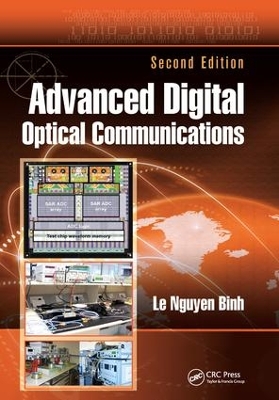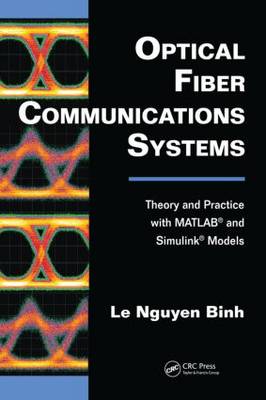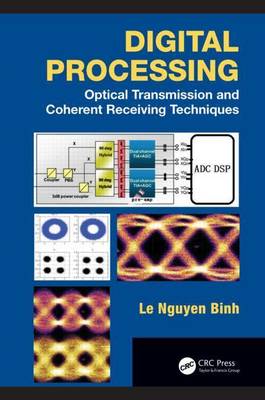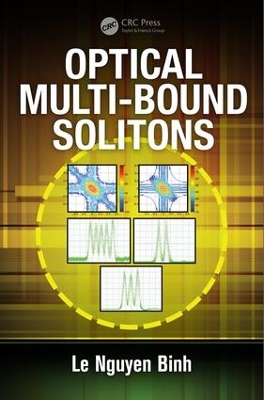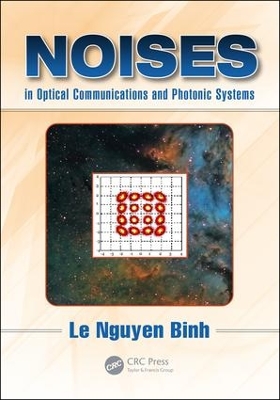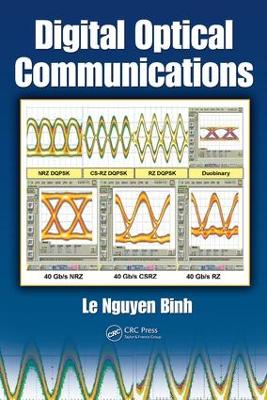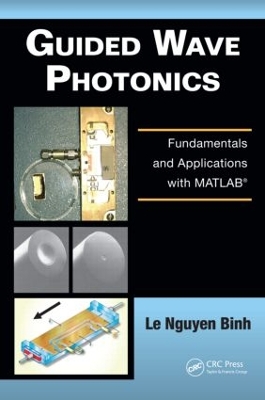Optics and Photonics
11 total works
This second edition of Digital Optical Communications provides a comprehensive treatment of the modern aspects of coherent homodyne and self-coherent reception techniques using algorithms incorporated in digital signal processing (DSP) systems and DSP-based transmitters to overcome several linear and nonlinear transmission impairments and frequency mismatching between the local oscillator and the carrier, as well as clock recovery and cycle slips. These modern transmission systems have emerged as the core technology for Tera-bits per second (bps) and Peta-bps optical Internet for the near future.
Featuring extensive updates to all existing chapters, Advanced Digital Optical Communications, Second Edition:
- Contains new chapters on optical fiber structures and propagation, optical coherent receivers, DSP equalizer algorithms, and high-order spectral DSP receivers
- Examines theoretical foundations, practical case studies, and MATLAB (R) and Simulink (R) models for simulation transmissions
- Includes new end-of-chapter practice problems and useful appendices to supplement technical information
Downloadable content available with qualifying course adoption
Advanced Digital Optical Communications, Second Edition supplies a fundamental understanding of digital communication applications in optical communication technologies, emphasizing operation principles versus heavy mathematical analysis. It is an ideal text for aspiring engineers and a valuable professional reference for those involved in optics, telecommunications, electronics, photonics, and digital signal processing.
Wireless communications allow high-speed mobile access to a global Internet based on ultra-wideband backbone intercontinental and terrestrial networks. Both of these environments support the carrying of information via electromagnetic waves that are wireless (in free air) or guided through optical fibers. Wireless and Guided Wave Electromagnetics: Fundamentals and Applications explores the fundamental aspects of electromagnetic waves in wireless media and wired guided media. This is an essential subject for engineers and physicists working with communication technologies, mobile networks, and optical communications.
This comprehensive book:
- Builds from the basics to modern topics in electromagnetics for wireless and optical fiber communication
- Examines wireless radiation and the guiding of optical waves, which are crucial for carrying high-speed information in long-reach optical networking scenarios
- Explains the physical phenomena and practical aspects of guiding optical waves that may not require detailed electromagnetic solutions
- Explores applications of electromagnetic waves in optical communication systems and networks based on frequency domain transfer functions in the linear regions, which simplifies the physical complexity of the waves but still allows them to be examined from a system engineering perspective
- Uses MATLAB® and Simulink® models to simulate and illustrate the electromagnetic fields
- Includes worked examples, laboratory exercises, and problem sets to test understanding
The book’s modular structure makes it suitable for a variety of courses, for self-study, or as a resource for research and development. Throughout, the author emphasizes issues commonly faced by engineers. Going a step beyond traditional electromagnetics textbooks, this book highlights specific uses of electromagnetic waves with a focus on the wireless and optical technologies that are increasingly important for high-speed transmission over very long distances.
Carefully structured to instill practical knowledge of fundamental issues, Optical Fiber Communication Systems with MATLAB (R) and Simulink (R) Models describes the modeling of optically amplified fiber communications systems using MATLAB (R) and Simulink (R). This lecture-based book focuses on concepts and interpretation, mathematical procedures, and engineering applications, shedding light on device behavior and dynamics through computer modeling.
Supplying a deeper understanding of the current and future state of optical systems and networks, this Second Edition:
- Reflects the latest developments in optical fiber communications technology
- Includes new and updated case studies, examples, end-of-chapter problems, and MATLAB (R) and Simulink (R) models
- Emphasizes DSP-based coherent reception techniques essential to advancement in short- and long-term optical transmission networks
Optical Fiber Communication Systems with MATLAB (R) and Simulink (R) Models, Second Edition is intended for use in university and professional training courses in the specialized field of optical communications. This text should also appeal to students of engineering and science who have already taken courses in electromagnetic theory, signal processing, and digital communications, as well as to optical engineers, designers, and practitioners in industry.
Carefully structured to provide practical knowledge on fundamental issues, Optical Fiber Communications Systems: Theory and Practice with MATLAB (R) and Simulink (R) Models explores advanced modulation and transmission techniques of lightwave communication systems. With coverage ranging from fundamental to modern aspects, the text presents optical communication techniques and applications, employing single mode optical fibers as the transmission medium. With MATLAB and Simulink models that illustrate methods, it supplies a deeper understanding of future development of optical systems and networks.
The book begins with an overview of the development of optical fiber communications technology over the last three decades of the 20th century. It describes the optical transmitters for direct and external modulation technique and discusses the detection of optical signals under direct coherent and incoherent reception. The author also covers lumped Er:doped and distributed Roman optical amplifiers with extensive models for the amplification of signals and structuring the amplifiers on the Simulink platform. He outlines a design strategy for optically amplified transmission systems coupled with MATLAB Simulink models, including dispersion and attenuation budget methodology and simulation techniques. The book concludes with coverage of advanced modulation formats for long haul optical fiber transmission systems with accompanied Simulink models.
Although many books have been written on this topic over the last two decades, most of them present only the theory and practice of devices and subsystems of the optical fiber communications systems in the fields, but do not illustrate any computer models to represent the true practical aspects of engineering practice. This book fills the need for a text that emphasizes practical computing models that shed light on the behavior and dynamics of the devices.
Ultrashort pulses in mode-locked lasers are receiving focused attention from researchers looking to apply them in a variety of fields, from optical clock technology to measurements of the fundamental constants of nature and ultrahigh-speed optical communications. Ultrashort pulses are especially important for the next generation of ultrahigh-speed optical systems and networks operating at 100 Gbps per carrier.
Ultra Fast Fiber Lasers: Principles and Applications with MATLAB (R) Models is a self-contained reference for engineers and others in the fields of applied photonics and optical communications. Covering both fundamentals and advanced research, this book includes both theoretical and experimental results. MATLAB files are included to provide a basic grounding in the simulation of the generation of short pulses and the propagation or circulation around nonlinear fiber rings. With its unique and extensive content, this volume-
Covers fundamental principles involved in the generation of ultrashort pulses employing fiber ring lasers, particularly those that incorporate active optical modulators of amplitude or phase types Presents experimental techniques for the generation, detection, and characterization of ultrashort pulse sequences derived from several current schemes Describes the multiplication of ultrashort pulse sequences using the Talbot diffraction effects in the time domain via the use of highly dispersive media Discusses developments of multiple short pulses in the form of solitons binding together by phase states Elucidates the generation of short pulse sequences and multiple wavelength channels from a single fiber laserThe most practical short pulse sources are always found in the form of guided wave photonic structures. This minimizes problems with alignment and eases coupling into fiber transmission systems. In meeting these requirements, fiber ring lasers operating in active mode serve well as suitable ultrashort pulse sources. It is only a matter of time before scientists building on this research develop the practical and easy-to-use applications that will make ultrahigh-speed optical systems universally available.
With coherent mixing in the optical domain and processing in the digital domain, advanced receiving techniques employing ultra-high speed sampling rates have progressed tremendously over the last few years. These advances have brought coherent reception systems for lightwave-carried information to the next stage, resulting in ultra-high capacity global internetworking. Digital Processing: Optical Transmission and Coherent Receiving Techniques describes modern coherent receiving techniques for optical transmission and aspects of modern digital optical communications in the most basic lines.
The book includes simplified descriptions of modulation techniques for such digital transmission systems carried by light waves. It discusses the basic aspects of modern digital optical communications in the most basic lines. In addition, the book covers digital processing techniques and basic algorithms to compensate for impairments and carrier recovery, as well as noise models, analysis, and transmission system performance.
Optical Multi-Bound Solitons describes the generation and transmission of multi-bound solitons with the potential to form the basis of the temporal coding of optical data packets for next-generation nonlinear optical systems. The book deals with nonlinear systems in terms of their fundamental principles, associated phenomena, and signal processing applications in contemporary optical systems for communications and laser systems, with a touch of mathematical representation of nonlinear equations to offer insight into the nonlinear dynamics at different phases. The text not only delineates the strong background physics of such systems but also:
- Discusses the phase evolution of the optical carriers under the soliton envelopes for the generation of multi-bound solitons
- Explains the generation of multi-bound solitons through optical fibers
- Examines new types of multi-bound solitons in passive and active optical resonators
- Conducts bi-spectral analyses of multi-bound solitons to identify the phase and power amplitude distribution property of bound solitons
- Presents experimental techniques for the effective generation of bound solitons
Optical Multi-Bound Solitons provides extensive coverage of multi-bound solitons from the dynamics of their formation to their transmission over guided optical media. Appendices are included to supplement a number of essential definitions, mathematical representations, and derivations, making this book an ideal theoretical reference text as well as a practical professional guidebook.
Transmitting information over optical fibers requires a high degree of signal integrity due to noise levels existing in optical systems. Proper methods and techniques for noise evaluations are critical in achieving high-performance.
This book provides a fundamental understanding of noise generation processes in optical communications and photonic signals. It discusses techniques for noise evaluation in optical communication systems, especially digital optical systems, as well as transmission systems performance and noise impacts in photonic processing systems
A comprehensive presentation of the theory and simulation of optical waveguides and wave propagations in a guided environment, Guided Wave Photonics: Fundamentals and Applications with MATLAB® supplies fundamental and advanced understanding of integrated optical devices that are currently employed in modern optical fiber communications systems and photonic signal processing systems. While there are many texts available in this area, none provide the breadth and depth of coverage and computational rigor found in this one.
The author has distilled the information into a very practical, usable format. In a logical progression of theory and application, he starts with Maxwell's equations and progresses directly to optical waveguides (integrated optic and fiber optic), couplers, modulators, nonlinear effects and interactions, and system applications. With up-to-date coverage of applicable algorithms, design guides, material systems, and the latest device and system applications, the book addresses:
- Fundamentals of guiding optical waves, including theoretical and simplified techniques
- Linear and nonlinear aspects of optical waveguiding
- Manipulating lightwaves by coupling and splitting
- Interactions of lightwaves and ultra-fast electrical travelling waves in modern optical modulators
- Applications of guided wave devices in optical communication systems and optical signal processing
Providing fundamental understanding of lightwave guiding and manipulating techniques, the text covers the field of integrated photonics by giving the principles, theoretical and applications. It explains how to solve the optical modes and their coupling as well as how to manipulate lightwaves for applications in communications and signal processing.
This books aims to present fundamental aspects of optical communication techniques and advanced modulation techniques and extensive applications of optical communications systems and networks employing single-mode optical fibers as the transmission system. New digital techqniues such as chromatic dispersion, polarization mode dispersion, nonlinear phase distortion effects, etc. will be discussed. Practical models for practice and understanding the behavior and dynamics of the devices and systems will be included.
